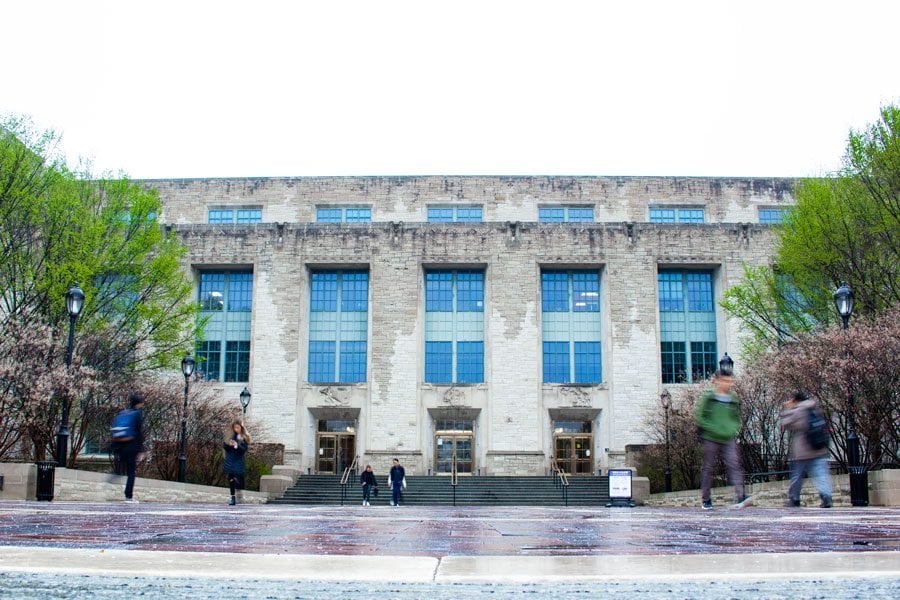Northwestern researchers find new weakness in virus that causes COVID-19
Daily file photo by Evan Robinson-Johnson
The Technological Institute. After finding an unexpected weakness in SARS-CoV-2, Northwestern researchers designed a molecule that reduces the virus’s ability to attach to human cell receptors.
August 18, 2020
Northwestern researchers have discovered a new potential weakness of SARS-CoV-2, the virus that causes COVID-19.
McCormick Prof. Monica Olvera de la Cruz and Baofu Qiao, a research assistant professor, published a study last week that identified vulnerability points in the virus, which can be used to impair the ability of the virus to bind to human cell receptors.
The study, published in the journal ACS Nano, focused on the “polybasic cleavage sites” of the virus, a feature that is unique to SARS-CoV-2 in comparison to many other coronaviruses.
The research was especially noteworthy due to the relatively far distance between the polybasic cleavage sites and the human-receptor binding site. The cleavage sites, though a mere 10 nanometers away, are usually seen as worlds apart in nanotechnological contexts.
“No one was attacking these sides before because they were far away,” Olvera de la Cruz told The Daily. “When you are in physiological conditions in your body, all of the electrostatics are supposed to screen within one nanometer — 10 times shorter distance. So they don’t think something so far away should affect it.”
The research suggested that modulating the behavior of the charges at the distant polybasic cleavage sites impaired ability of the virus to bind to human cells.
There are three polybasic cleavage sites on SARS-CoV-2, which each lay relatively far away from where the location where the virus latches onto human cell receptors.
Qiao said he and Olvera de la Cruz were attracted to studying the polybasic cleavage sites because of their uniqueness to SARS-CoV-2. The sites were not present in the 2003 SARS virus, and are usually not found in other, similar coronaviruses.
“It is unique,” said Qiao, the principal author of the study. “People now have very limited knowledge on these polybasic cleavage sites, and our work at least shows some function of these sites. It’s not the full story, but I think it tells us a little bit about these polybasic cleavage sites.”
In the past, scientists have widely dismissed the sites as being too far away to show any effect on human binding.
“People were not expecting that it was important,” Olvera de la Cruz said. “It’s a new thing, and it’s going to explain other things that people were thinking, ‘Oh it shouldn’t matter.’ But they do matter. So for me as a scientist, that was a discovery.”
The surprising finding led Olvera de la Cruz and Qiao to develop a molecule that could cancel out the positive charge of the polybasic cleavage site. Through computer simulations, Olvera de la Cruz and Qiao designed a small negatively charged molecule that binds to a cleavage site and alters its charge.
According to the simulations, Olvera de la Cruz said the molecule they designed reduced the virus’s ability to bind to human cells by 30 percent.
“It only binded to one (polybasic cleavage site),” Olvera de la Cruz said. “Now we need to get a molecule that binds to the three, to get more and more reduction. But it’s hard to design that molecule.”
Currently, Olvera de la Cruz and Qiao are teaming up with Feinberg Prof. Valerie Tokars to construct a longer molecule. The new molecule will be able to attack multiple sites at once to further hamper the binding ability of the virus.
If the new project is as successful as the last, Qiao said the team may eventually move on to clinical trials, bringing the research outside the lab and onto the frontlines where COVID-19 has upended life throughout the world.
But for now, Tokars said that scientists like herself are careful not to get too excited about one single research project.
“It’s hard to predict what’s going to come out of things,” Tokars said. “We are one of many groups participating in this global effort to beat this COVID-19. So I’m of the viewpoint that collectively, our knowledge will really help us win this fight.”
Email: [email protected]
Twitter: @jasonbeeferman
Related stories:
— NU researchers develop wearable device that helps monitor COVID-19 symptoms
— Northwestern researchers find a dramatic increase in food insecurity during COVID-19 pandemic


